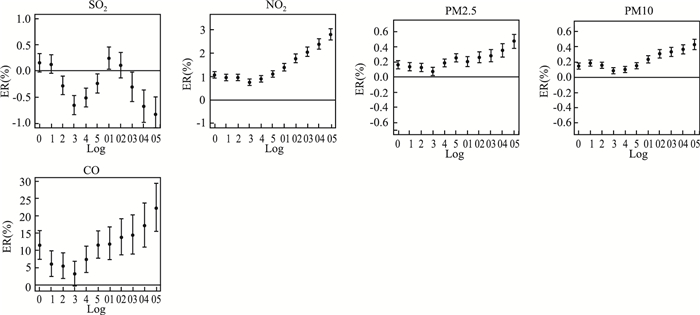The impact of air pollution on children's respiratory diseases in Tianjin: a case-over study
-
摘要:
目的 探求大气污染对天津市儿童呼吸系统疾病的影响,为疾病的预防与控制提供依据。 方法 利用单污染物和多污染物条件Logistic回归模型,来估计空气污染物浓度和儿童呼吸系统疾病发病之间的关系。 结果 单污染物条件Logistic回归模型显示,大气中NO2、PM2.5、PM10、CO的超额危险度(excess risk rate,ER)及其95%CI分别为2.823%(2.581~3.065)、0.476%(0.382~0.569)、0.437%(0.368~0.506)、22.263%(15.449~29.478)。多污染物条件Logistic回归分析显示:在寒冷季节,NO2暴露对儿童呼吸系统疾病的影响效应最大,ER及其95%CI为7.395%(6.595~8.202)。 结论 NO2、PM10、PM2.5、CO日平均浓度的升高可以增高儿童呼吸系统疾病的发生风险。 Abstract:Objective To explore the effect of air pollution on children's respiratory diseases in Tianjin, so as to provide reference for the prevention and control of diseases. Methods Conditional Logistic regression model of single pollutant and multiple pollutants was used to estimate the relationships between air pollutants concentration and children's respiratory system diseases. Results Conditional Logistic regression model of single pollutant conditions showed that the excess risk (ER) effects and 95% CI of NO2, PM2.5, PM10 and CO appeared were 2.823%(2.581-3.065), 0.476%(0.382-0.569), 0.437%(0.368-0.506), 22.263%(15.449-29.478), respectively. Logistic regression analysis of multiple pollutants conditions showed that NO2 exposure had the greatest effect on children's respiratory diseases in cold season, and the excess risk (ER) was 7.395%(6.595-8.202). Conclusion The elevated daily average concentration of NO2, PM10, PM2.5, and CO can increase the risk of children's respiratory diseases. -
Key words:
- Air pollution /
- Children /
- Respiratory diseases /
- Case-over study
-
表 1 SO2、NO2、PM2.5、PM10、CO对儿童呼吸系统疾病日门诊量的单污染物的条件Logistic回归分析a
Table 1. Logistic regression analysis of SO2, NO2, PM2.5, PM10 and CO on the daily hospital admissions of children's respiratory diseases in single pollutant modela
滞后日 SO2(μg·m-3) NO2(μg·m-3) PM2.5(μg·m-3) PM10(μg·m-3) CO(μg·m-3) Lag0 0.16%(-0.02~0.33) 1.09%(0.94~1.23)b 0.17%(0.11~0.22)b 0.15%(0.11~0.20)b 11.60%(7.56~15.80)b Lag1 0.13%(-0.05~0.31) 0.97%(0.83~1.11)b 0.14%(0.09~0.20)b 0.19%(0.15~0.23)b 6.24%(2.54~10.08)b Lag2 -0.28%(-0.46~-0.10)b 0.98%(0.83~1.12)b 0.13%(0.08~0.19)b 0.16%(0.12~0.20)b 5.66%(2.03~9.42)b Lag3 -0.66%(-0.84~-0.48)b 0.77%(0.63~0.91)b 0.08%(0.03~0.13)b 0.09%(0.05~0.13)b 3.37%(-0.19~7.06) Lag4 -0.51%(-0.69~-0.33)b 0.92%(0.78~1.06)b 0.19%(0.14~0.24)b 0.11%(0.07~0.15)b 7.52%(3.82~11.36)b Lag5 -0.24%(-0.42~-0.06)b 1.12%(0.97~1.26)b 0.26%(0.21~0.31)b 0.15%(0.12~0.19)b 11.72%(7.90~15.68)b Lag01 0.25%(0.03~0.46)b 1.41%(1.25~1.58)b 0.21%(0.15~0.28)b 0.24%(0.19~0.29)b 11.99%(7.48~16.70)b Lag02 0.12%(-0.14~0.36) 1.80%(1.61~1.98)b 0.27%(0.19~0.34)b 0.31%(0.26~0.37)b 13.86%(8.85~19.10)b Lag03 -0.30%(-0.58~-0.02)b 2.08%(1.87~2.29)b 0.29%(0.21~0.37)b 0.34%(0.28~0.40)b 14.55%(9.06~20.31)b Lag04 -0.67%(-0.99~-0.36)b 2.41%(2.18~2.63)b 0.36%(0.27~0.44)b 0.37%(0.31~0.43)b 17.24%(11.16~23.65)b Lag05 -0.83%(-1.17~-0.49) 2.82%(2.58~3.07)b 0.48%(0.38~0.57)b 0.44%(0.37~0.51)b 22.26%(15.45~29.48)b 注:a表示表中数值为各污染物的ER值及95% CI,b表示差异有统计学意义(P<0.001)。 表 2 SO2、NO2、PM2.5、PM10、CO对儿童呼吸系统疾病日门诊量的多污染物的条件Logistic回归分析a
Table 2. Logistic regression analysis of SO2, NO2, PM2.5, PM10 and CO on the daily hospital admissions of children's respiratory diseases in multi-pollutants modela
全观察期 温暖季节(5月~10月) 寒冷季节(11月~次年4月) SO2 -0.78%(-0.97~-0.58)b -0.73%(-0.93~-0.52)b -0.74%(-1.46~-0.01)b NO2 5.12%(4.73~5.52)b 5.31%(4.78~5.84)b 7.40%(6.60~8.20)b PM10 0.56%(0.42~0.69)b 0.70%(0.53~0.88)b 0.01%(-0.22~0.23)b PM2.5 -1.17%(-1.39~-0.96)b -1.59%(-1.85~-1.32)b -0.13%(-0.57~0.31)b CO -29.19%(-34.84~-23.04)b -18.61%(-25.53~-11.04)b -86.38%(-89.50~-82.32)b 注:a表示表中数值为各污染物的ER值及95% CI,b表示差异具有统计学意义(P<0.001)。 -
[1] Chen R, Yin P, Meng X, et al. Fine particulate air pollution and daily mortality. A Nationwide Analysis in 272 Chinese Cities[J]. Am J Respir Crit Care Med, 2017, 196(1): 73-81. DOI: 10.1164/rccm.201609-1862OC. [2] 丁亚萍, 虞明星, 郝海燕, 等. 石家庄市空气PM 2.5浓度与儿童呼吸系统疾病门诊量的关系[J]. 中华疾病控制杂志, 2018(7): 672-676. DOI: 10.16462/j.cnki.zhjbkz.2018.07.005.Ding YP, Yu MX, Hao HY, et al. The relationship between fine particulate matter and hospital outpatients with pediatric respiratory[J]. Chin J Dis Contl Prev, 2018(7): 672-676. DOI: 10.16462/j.cnki.zhjbkz.2018.07.005. [3] Kurt OK, Zhang J, Pinkerton KE. Pulmonary health effects of air pollution[J]. Curr Opin Pulm Med, 2016, 22(2): 138-143. DOI: 10.1097/MCP.0000000000000248. [4] Maclure M. The case-crossover design: a method for studying transient effects on the risk of acute events[J]. Am J Epidemiol, 1991, 133(2): 144-153. DOI: 10.1093/oxfordjournals.aje.a115853. [5] Schwartz J. Is the association of airborne particles with daily deaths confounded by gaseous air pollutants? An approach to control by matching[J]. Environ Health Perspect, 2004, 112(5): 557-561. DOI: 10.1289/ehp.6431. [6] Levy D, Lumley T, Sheppard L, et al. Referent selection in case-crossover analyses of acute health effects of air pollution[J]. Epidemiology, 2001, 12(2): 186-192. DOI: 10.2307/3703621. [7] Janes H, Sheppard L, Lumley T. Case-crossover analyses of air pollution exposure data: referent selection strategies and their implications for bias[J]. Epidemiology, 2005, 16(6): 717-726. DOI: 10.1097/01.ede.0000181315.18836.9d. [8] Carracedo-Martinez E, Taracido M, Tobias A, et al. Case-crossover analysis of air pollution health effects: a systematic review of methodology and application[J]. Environ Health Perspect, 2010, 118(8): 1173-1182. DOI: 10.1289/ehp.0901485. [9] Kim KH, Kabir E, Kabir S. A review on the human health impact of airborne particulate matter[J]. Environ Int, 2015, 74: 136-143. DOI: 10.1016/j.envint.2014.10.005. [10] Amodio M. How a steel plant affects air quality of a nearby urban area: a study on metals and PAH concentrations[M]. 2013. DOI: 10.4209/aaqr.2012.09.0254. [11] Shubhankar B, Ambade B. A review on deposition, distribution of polycyclic aromatic hydrocarbons in different environmental matrix and study its toxicity and carcinogenic effect[M]. 2016: 2341-2345. DOI: 10.14233/ajchem.2016.20096. [12] Dai Q. Characterization and source identification of heavy metals in ambient PM10 and PM2.5 in an integrated iron and steel industry zone compared with a background site[M]. 2015. DOI: 10.4209/aaqr.2014.09.0226. [13] Wiseman C, Zereini F. Airborne particulate matter, platinum group elements and human health[M]. 2010.553-571. DOI: 10.1007/978-3-642-12278-1_28. [14] 刘准, 陈丹, 霍细香, 等. 武汉市大气污染物水平与儿童呼吸道疾病门诊量的滞后效应分析[J]. 环境与职业医学, 2018(2): 124-130. DOI: 10.13213/j.cnki.jeom.2018.17650.Liu Z, Chen D, Huo XX, et al. Lag effects of air pollutant levels on pediatric respiratory disease outpatient visits in Wuhan[J]. Journal of Environmental and Occupational Medicine, 2018(2): 124-130. DOI: 10.13213/j.cnki.jeom.2018.17650. [15] Chen R, Pan G, Zhang Y, et al. Ambient carbon monoxide and daily mortality in three Chinese cities: the China Air Pollution and Health Effects Study (CAPES)[J]. Sci Total Environ, 2011, 409(23): 4923-4928. DOI: 10.1016/j.scitotenv.2011.08.029. [16] Kan H, Wong CM, Vichit-Vadakan N, et al. Short-term association between sulfur dioxide and daily mortality: the Public Health and Air Pollution in Asia (PAPA) study[J]. Environ Res, 2010, 110(3): 258-264. DOI: 10.1016/j.envres.2010.01.006. [17] Kahnert K, Lucke T, Biertz F, et al. Transfer factor for carbon monoxide in patients with COPD and diabetes: results from the German COSYCONET cohort[J]. Respir Res, 2017, 18(1): 14. DOI: 10.1186/s12931-016-0499-0. [18] Carey WA, Weaver AL, Mara KC, et al. Inhaled nitric oxide in extremely premature neonates with respiratory distress syndrome[J]. Pediatrics, 2018, 141(3): e20173108. DOI: 10.1542/peds.2017-3108. [19] Zhang J, Zhu T, Kipen H, et al. Cardiorespiratory biomarker responses in healthy young adults to drastic air quality changes surrounding the 2008 Beijing Olympics[J]. Res Rep Health Eff Inst, 2013(174): 5-174. [20] Mirowsky JE, Dailey LA, Devlin RB. Differential expression of pro-inflammatory and oxidative stress mediators induced by nitrogen dioxide and ozone in primary human bronchial epithelial cells[J]. Inhal Toxicol, 2016, 28(8): 374-382. DOI: 10.1080/08958378.2016.1185199. [21] Chuang KJ, Chan CC, Su TC, et al. The effect of urban air pollution on inflammation, oxidative stress, coagulation, and autonomic dysfunction in young adults[J]. Am J Respir Crit Care Med, 2007, 176(4): 370-376. DOI: 10.1164/rccm.200611-1627OC. [22] Chen X, Wang X, Huang JJ, et al. Nonmalignant respiratory mortality and long-term exposure to PM10 and SO2: A 12-year cohort study in northern China[J]. Environ Pollut, 2017, 231(Pt 1): 761-767. DOI: 10.1016/j.envpol.2017.08.085. [23] Liu Y, Xie S, Yu Q, et al. Short-term effects of ambient air pollution on pediatric outpatient visits for respiratory diseases in Yichang city, China[J]. Environ Pollut, 2017, 227: 116-124. DOI: 10.1016/j.envpol.2017.04.029. [24] Bougas N, Ranciere F, Beydon N, et al. Traffic-related air pollution, lung function, and host vulnerability. New Insights from the PARIS Birth Cohort[J]. Ann Am Thorac Soc, 2018, 15(5): 599-607. DOI: 10.1513/AnnalsATS.201711-900OC. [25] Tao M, Chen L, Su L, et al. Satellite observation of regional haze pollution over the North China Plain[J]. Journal of Geophysical Research Atmospheres, 2012, 117(D12). DOI: 10.1029/2012JD017915. [26] Tao M, Chen L, Xiong X, et al. Formation process of the widespread extreme haze pollution over northern China in January 2013: Implications for regional air quality and climate[M]. 2014: 417-425. DOI: 10.1016/j.atmosenv.2014.09.026. [27] Zhang Z, Zhang X, Gong D, et al. Possible influence of atmospheric circulations on winter hazy pollution in Beijing-Tianjin-Hebei region, northern China[M]. 2015: 22493-22526. DOI: 10.5194/acpd-15-22493-2015. [28] Luo M, Hou X, Gu Y, et al. Trans-boundary air pollution in a city under various atmospheric conditions[J]. Sci Total Environ, 2018, 618: 132-141. DOI: 10.1016/j.scitotenv.2017.11.001. [29] Ning G, Wang S, Ma M, et al. Characteristics of air pollution in different zones of Sichuan Basin, China[J]. Sci Total Environ, 2018, 612: 975-984. DOI: 10.1016/j.scitotenv.2017.08.205. -





 下载:
下载:

